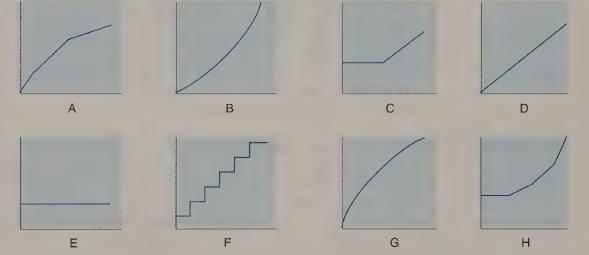In practice, there is often a tendency to simplify approximations of cost behaviour patterns, even though the
Question:
In practice, there is often a tendency to simplify approximations of cost behaviour patterns, even though the “true” underlying behaviour is not simple. Choose from the accompanying graphs A through H
(below) the one that matches the numbered “items. Indicate by letter which graph best fits each of the situations described. Next to each number-letter pair, identify a likely cost driver for that cost.
The vertical axes of the graphs represent total dollars of costs incurred, and the horizontal axes represent levels of cost driver activity during a particular time period. The graphs may be used more than once.

1. Availability of quantity discounts, where the cost per unit falls as each price break is reached.
2. Price of an increasingly scarce raw material as the quantity used increases.
3. Guaranteed annual wage plan, whereby workers get paid for 40 hours of work per week even at zero or low levels of production that require working only a few hours weekly.
4, Water bill, which entails a flat fee for the first 10,000 litres used and then an increasing unit cost for every additional 10,000 litres used.
5. Cost of machining labour that tends to decrease as workers gain experience.
6. Amortization of office equipment.
7. Cost of sheet steel for a manufacturer of farm implements.
8. Salaries of supervisors, where one supervisor is added for every 12 phone solicitors.
9. Natural gas bill consisting of a fixed component, plus a constant variable cost per thousand cubic metres after a specified number of cubic metres are used.
Step by Step Answer:

Management Accounting
ISBN: 9780367506896
5th Canadian Edition
Authors: Charles T Horngren, Gary L Sundem, William O Stratton, Howard D Teall, George Gekas




